CADILLAC FLEETWOOD 1993 2.G Owners Manual
Manufacturer: CADILLAC, Model Year: 1993, Model line: FLEETWOOD, Model: CADILLAC FLEETWOOD 1993 2.GPages: 386, PDF Size: 19.17 MB
Page 261 of 386
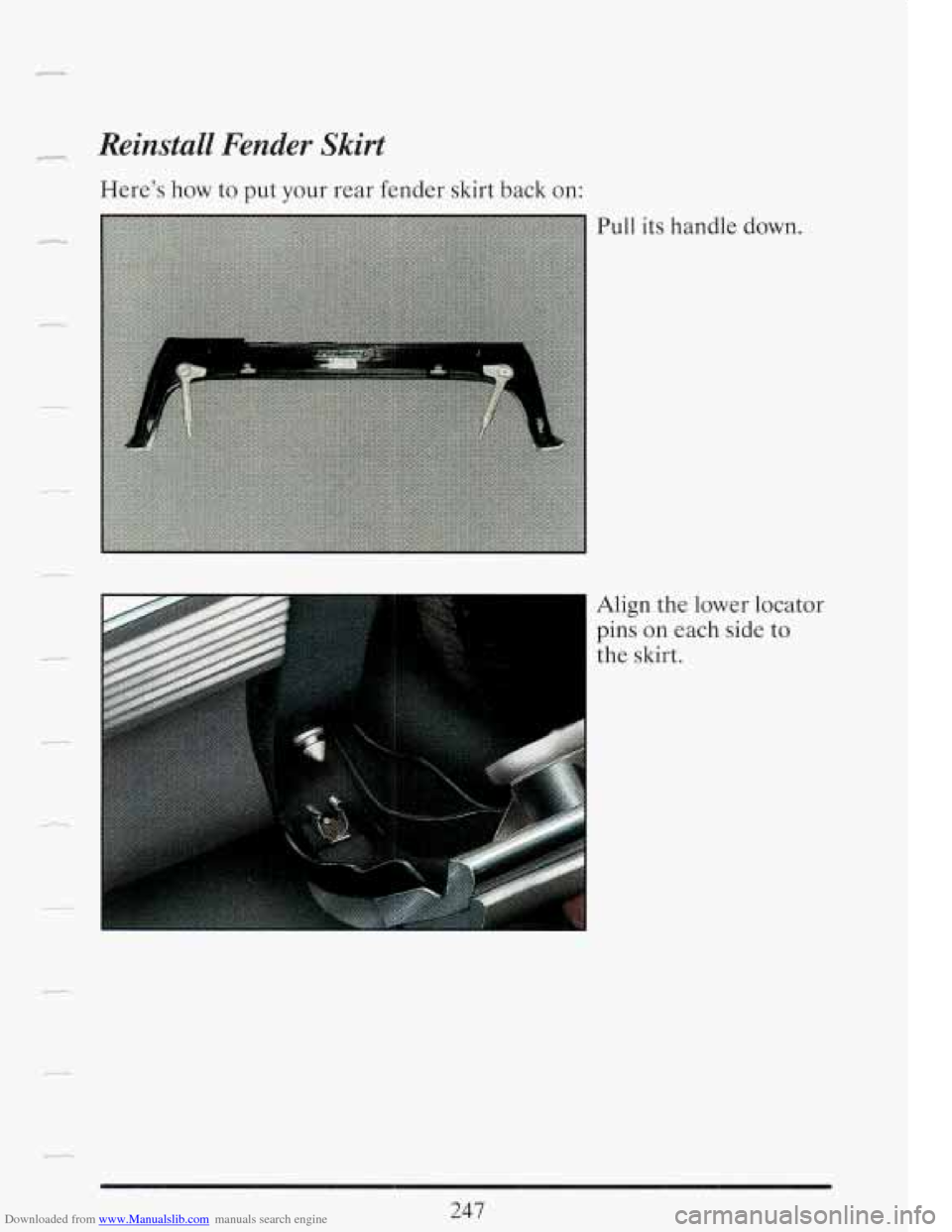
Downloaded from www.Manualslib.com manuals search engine Reinstall Fender Skirt
Here’s how to put your rear fender skirt back on:
Pull its ha .I .dle down.
1: ,
Align the lower locator
Tins
on each side to
:he skirt.
Page 262 of 386
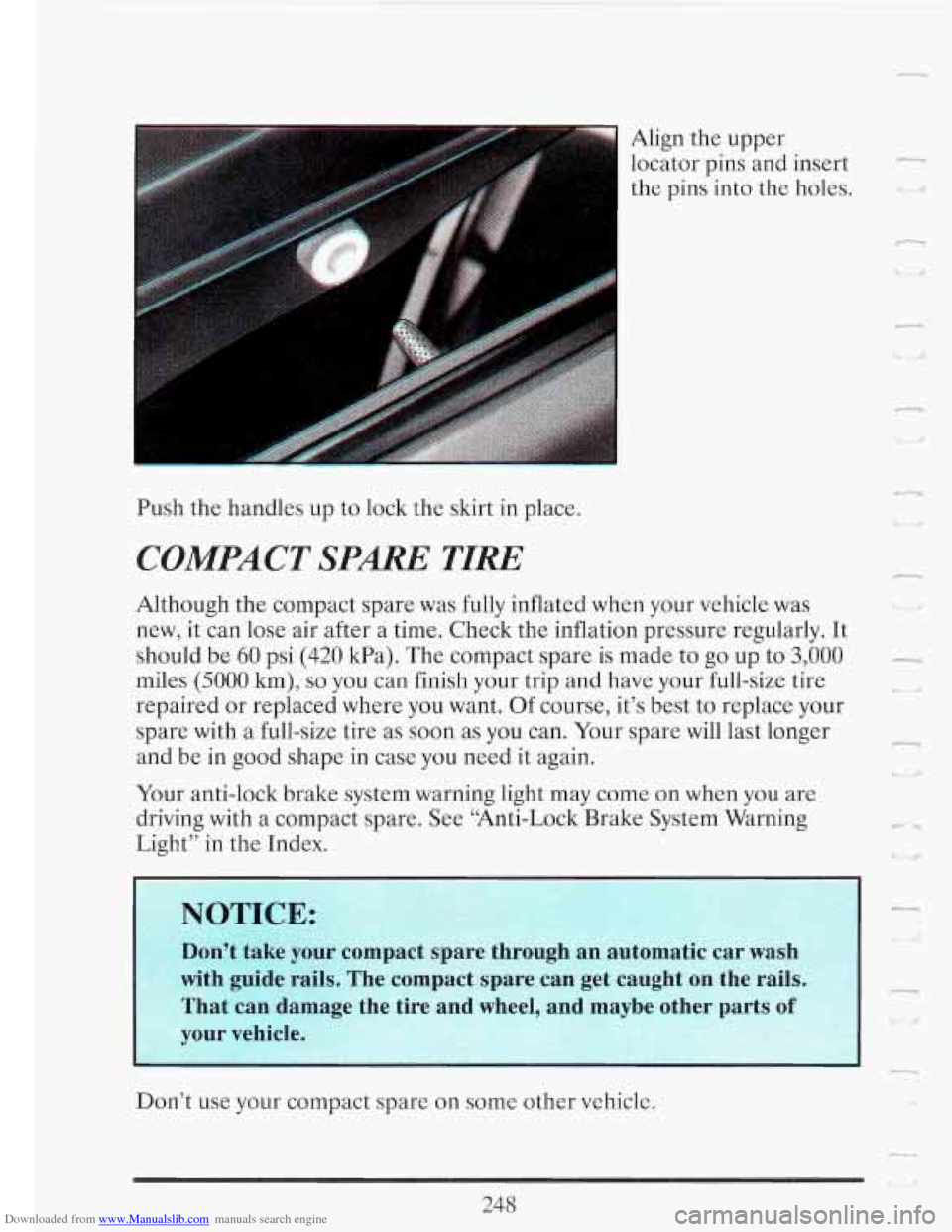
Downloaded from www.Manualslib.com manuals search engine Align the upper
locator pins and insert
-
the pins into the holes. .
n
Push the handles up to lock the skirt in place.
COMPACT SPARE TIRE
Although the compact spare was fully inflated when your vehicle was
new, it can lose air after a time. Check the inflation pressure regularly. It
should be
60 psi (420 kPa). The compact spare is made to go up to 3,000 -
miles (5000 km), so you can finish your trip and have your full-size tire i* u
repaired or replaced where you want. Of course, it’s best to replace your I
spare with a full-size tire as soon as you can. Your spare will last longer
and be in good shape in case you need it again.
Your anti-lock brake system warning light may come on when
you are
driving with a compact spare. See “Anti-Lock Brake System Warning
Light” in the Index.
Don’t use your compact spare on some other vehicle.
248
Page 263 of 386
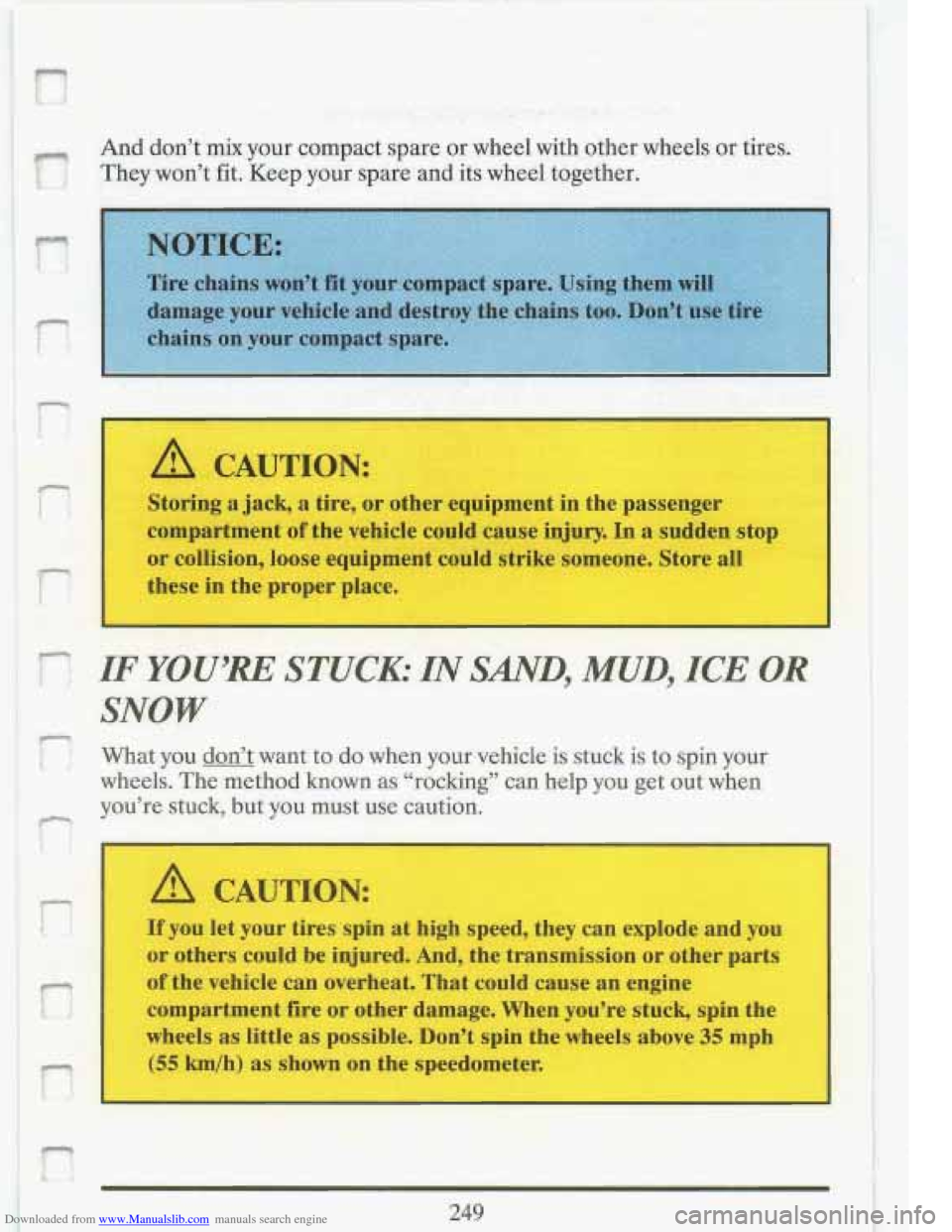
Downloaded from www.Manualslib.com manuals search engine And don't mix your compact spare or wheel with other wheels or tires.
They won't
fit. Keep your spare and its wheel together.
. - ':.-
'. * , F, . - ;,:: .-
Storing a jack, a tire, or other equipment in the passenger
compartment of the vehicle could cause injury. In
a sudden stop
or collision, loose equipment could strike someone. Store
all
these in the proper place.
,.-IF YOU'RE STUCK: IN SAND, MUD, ICE OR
at you don't want to do when your vehicle is stuck is to spin your
wheels. The method known
as "rocking" can help you get out when
Tw're stuck, but you must use caution.
A CAUTION:
If you let your tires spin at high speed, they can explode and you
or others could be injured. And, the transmission
or other parts
of the vehicle can overheat. That could cause an engine
compartment fire or other damage. When you're stuck, spin the
wheels as little as possible. Don't spin the wheels above
35 mph
(55 km/h) as shown on the speedometer.
I
i
Page 264 of 386
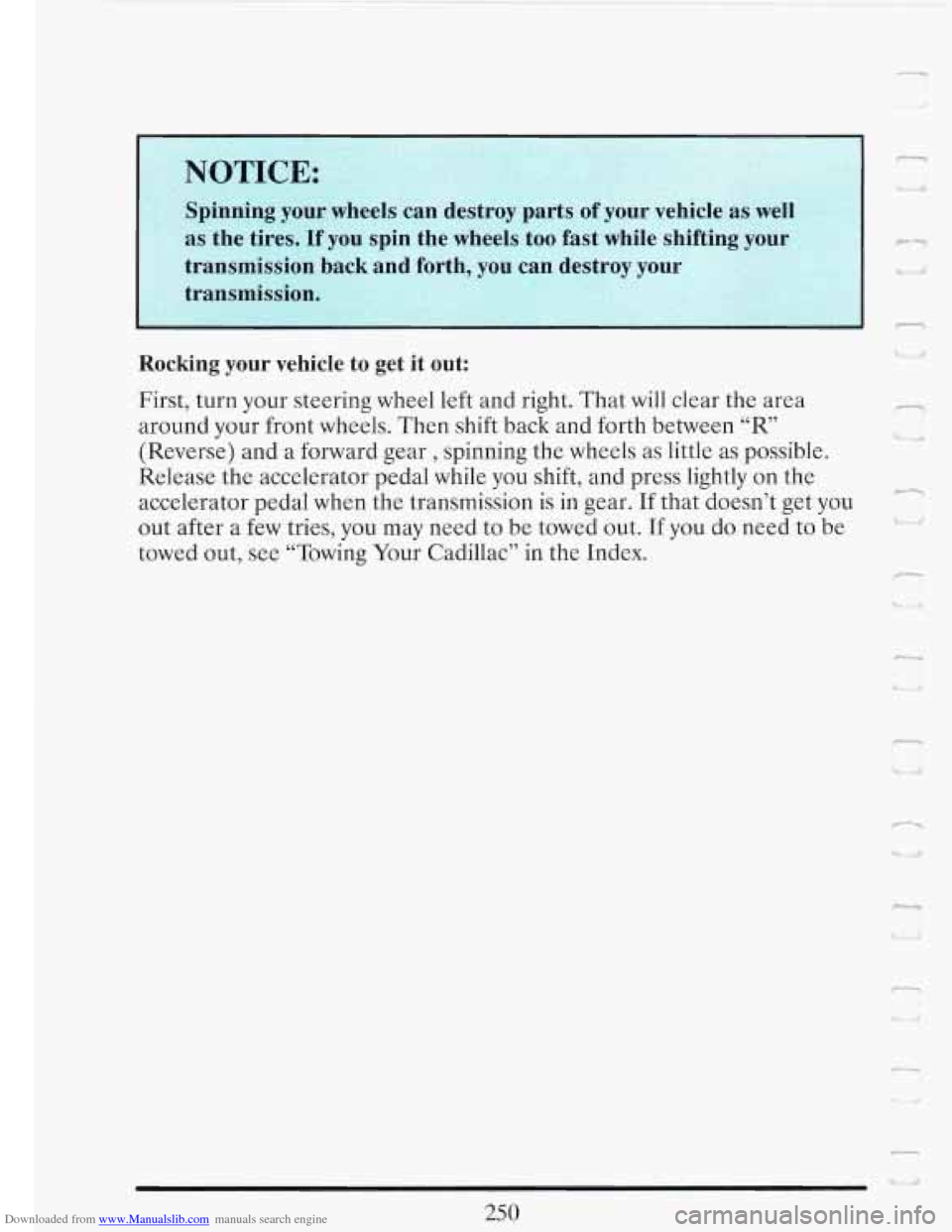
Downloaded from www.Manualslib.com manuals search engine L Rocking your vehicle to get it out:
a’ I
First, turn your steering wheel left and right. That will clear the area
around your front wheels. Then shift back and forth between
“R7
(Reverse) and a forward gear , spinning the wheels as little as possible.
Release the accelerator pedal while you shift, and press lightly on the
accelerator pedal when the transmission
is in gear. If that doesn’t get you
out after a
few tries, you may need to be towed out. If you do need to be
towed out, see “Towing Your Cadillac” in the Index.
--
250
Page 265 of 386
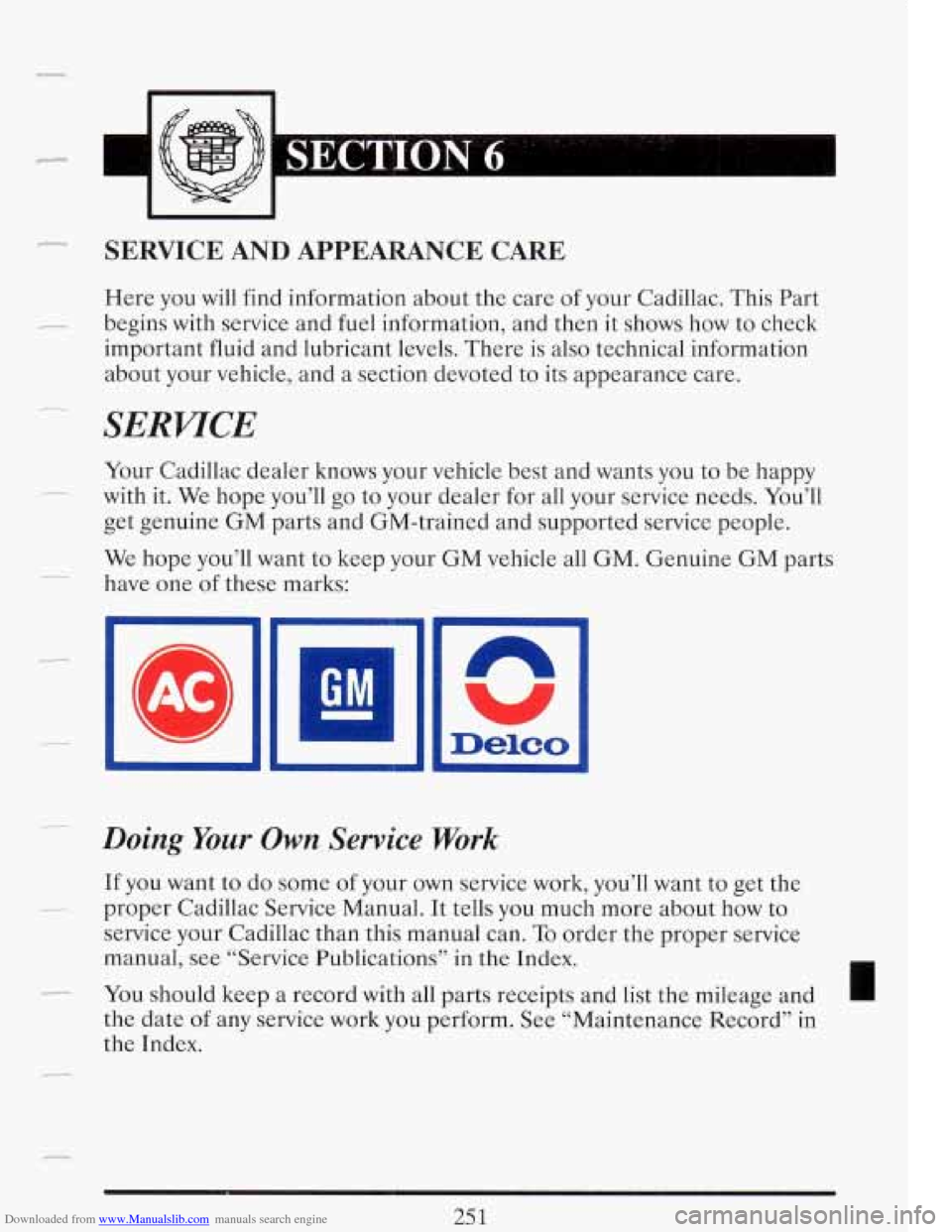
Downloaded from www.Manualslib.com manuals search engine r
SERVICE AND APPEARANCE CARE
Here you will find information about the care of your Cadillac. This Part
begins with service and fuel information, and then it shows how to check
important fluid and lubricant levels. There is also technical information
about your vehicle, and a section devoted to its appearance care.
SERWCE
Your Cadillac dealer knows your vehicle best and wants you to be happy
with it. We hope you’ll go to your dealer for all your service needs. You’ll
get genuine GM parts and GM-trained and supported service people.
We hope you’ll want to keep your GM vehicle all GM. Genuine GM parts
have one of these marks:
w wu
A
Doing Your Own Service Work
If you want to do some of your own service work, you’ll want to get the
service your Cadillac than this manual can.
To order the proper service
manual, see “Service Publications” in the Index.
- proper Cadillac Service Manual. It tells you much more about how to
,- You should keep a record with all parts receipts and list the mileage and I
the date of any service work you perform. See “Maintenance Record” in
the Index.
25 1
Page 266 of 386
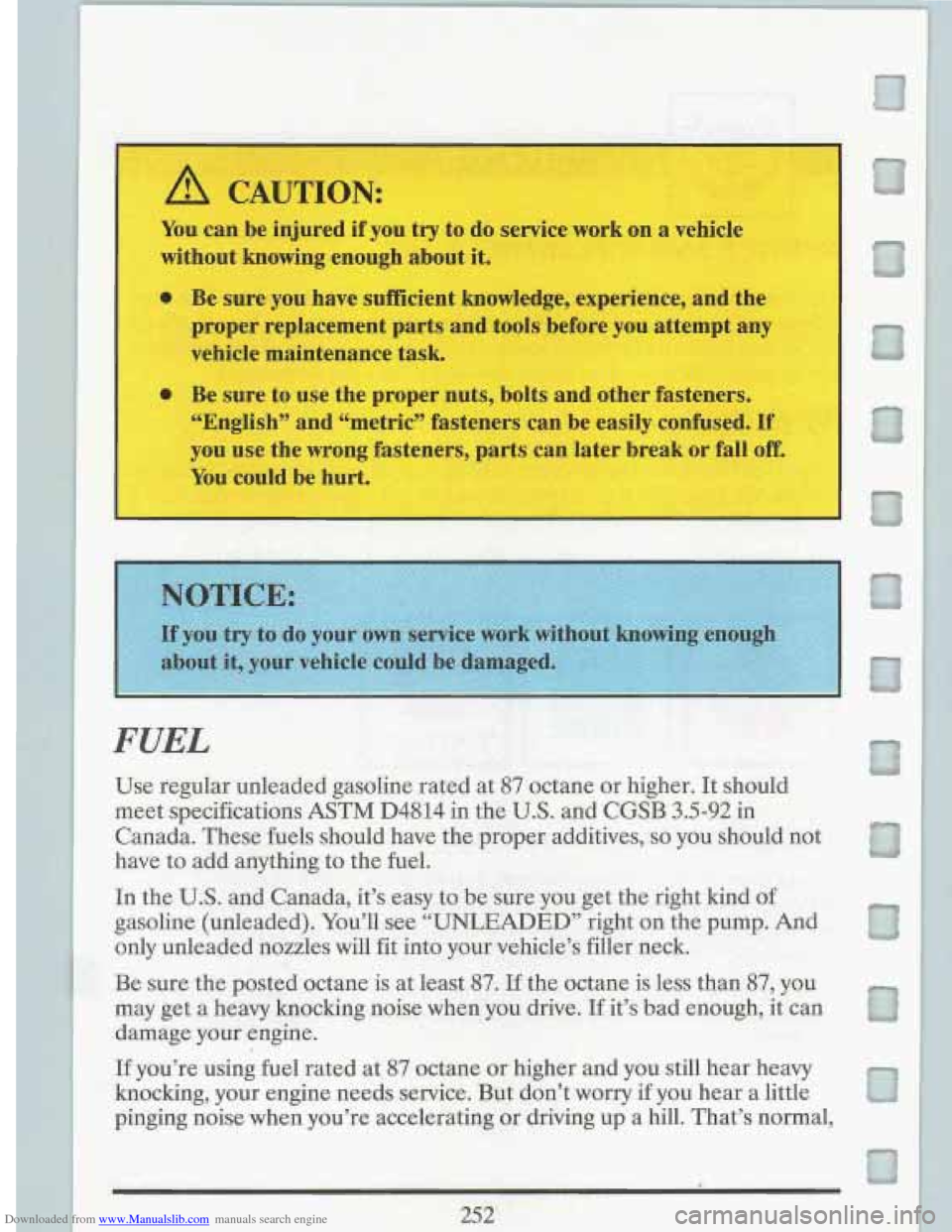
Downloaded from www.Manualslib.com manuals search engine A CAUTION:
You can be injured if you try to do service work on a vehicle
without knowing enough about it.
0 Be sure you have sufficient knowledge, experience, and the
proper replacement parts and tools before you attempt any
vehicle maintenance task.
0 Be sure to use the proper nuts, bolts and other fasteners.
“English” and “metric” fasteners can be easily confused.
If
you use the wrong fasteners, parts can later break or fall off.
You could be hurt.
1DOUt
FUEL
Use regular unleaded gasoline rated at 87 octane or higher. It should
meet specifications
ASTM D4814 in the U.S. and CGSB 3.5-92 in
Canada. These fuels should have the proper additives,
so you should not
have to add anything to the fuel.
1 the U.S. and Canada, it’s easy to be sure you get the right kind of
gasoline (unleaded). You’ll see
“UNLEADED” right on the pump. And
only unleaded nozzles will fit into your vehicle’s filler neck.
Be sure the posted octane is at least
87. If the octane is less than 87, you
may get a heavy knocking noise when you drive. If it’s bad enough, it can
damage your engine.
If you’re using fuel rated at
87 octane or higher and you still hear heavy
knocking, your engine needs service. But don’t worry if you hear a little
pinging noise when you’re accelerating
or driving up a hill. That’s normal,
Page 267 of 386
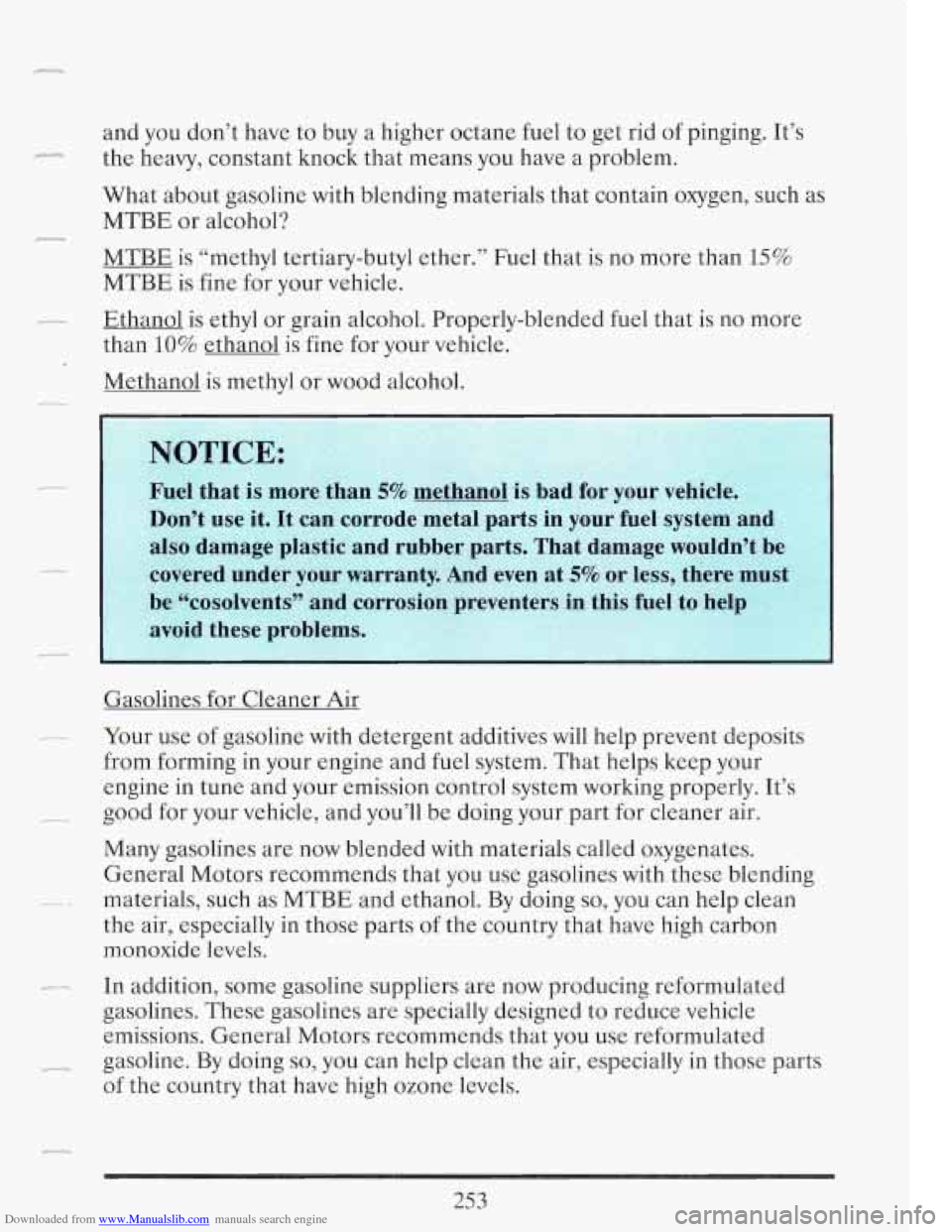
Downloaded from www.Manualslib.com manuals search engine r
J
r
and you don’t have to buy a higher octane fuel to get rid of pinging. It’s
the heavy, constant knock that means you have
a problem.
What about gasoline with blending materials that contain oxygen, such as
MTBE or alcohol?
MTBE is “methyl tertiary-butyl ether.’’ Fuel that is no more than
15%
MTBE is fine for your vehicle.
Ethanol is ethyl or grain alcohol. Properly-blended fuel that is no more
than
10% ethanol is fine for your vehicle.
Methanol is methyl or wood alcohol.
Gasolines for Cleaner &r
.. -- Your use of gasoline with detergent additives will help prevent deposits
from forming in your engine and fuel system. That helps keep your
engine
in tune and your emission control system working properly. It’s
~ good for your vehicle, and you’ll be doing your part for cleaner air.
Many gasolines are now blended with materials called oxygenates.
General Motors recommends that you use gasolines with these blending
. materials, such as MTBE and ethanol. By doing so, you can help clean
the air, especially in those parts of the country that have high carbon
monoxide levels.
c- In addition, some gasoline suppliers are now producing reformulated
- gasoline. By doing so, you can help clean the air, especially in those parts
gasolines.
These gasolines are specially designed to reduce vehicle
emissions. General Motors recommends that you use reformulated
of the country that have high ozone levels.
253
Page 268 of 386
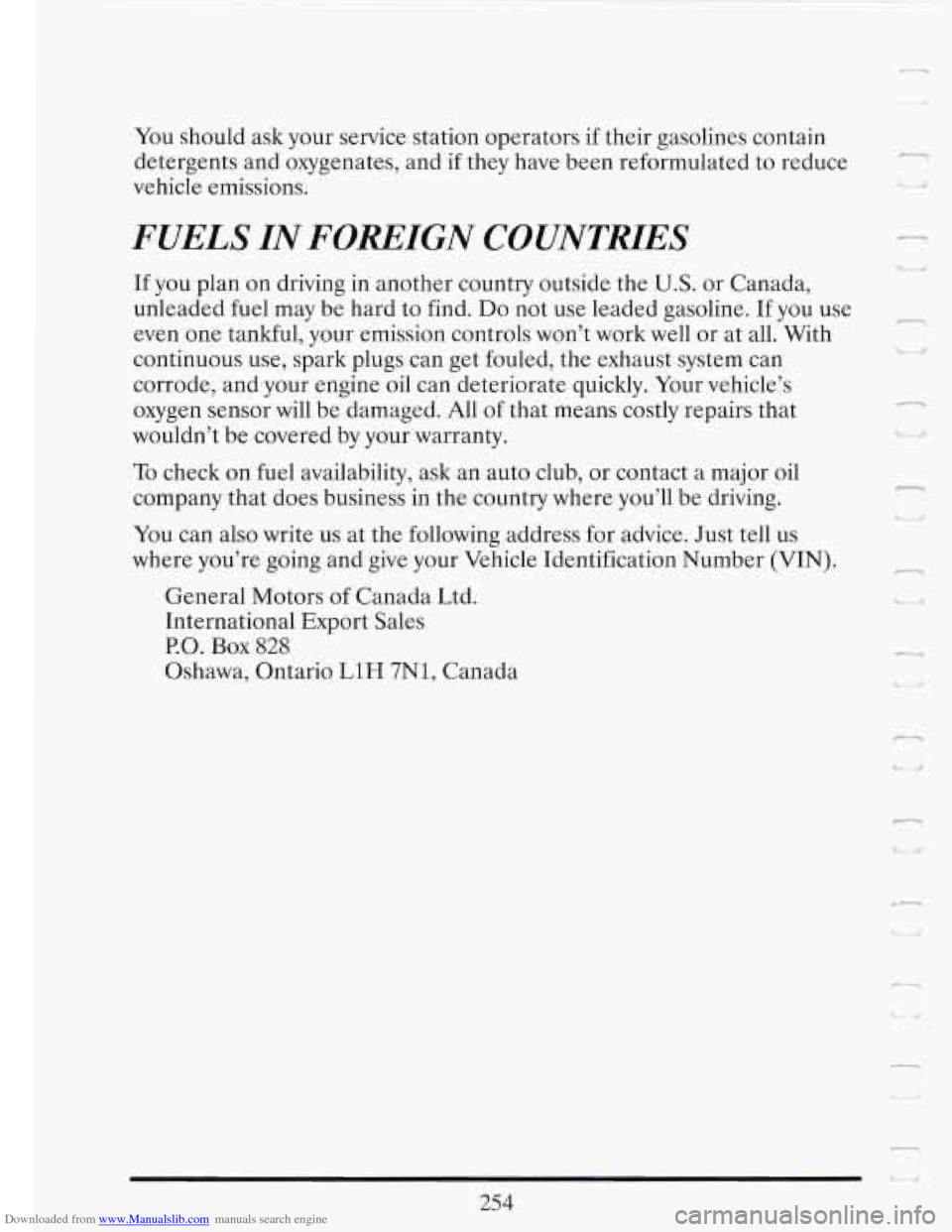
Downloaded from www.Manualslib.com manuals search engine You should ask your service station operators if their gasolines contain
detergents and oxygenates, and if they have been reformulated to reduce
vehicle emissions.
FUELS IN FOREIGN COUNTMES
If you plan on driving in another country outside the U.S. or Canada,
unleaded fuel may be hard to find.
Do not use leaded gasoline. If you use
even one tankful, your emission controls won’t work well or at all. With
continuous use, spark plugs can get fouled, the exhaust system can
corrode, and your engine
oil can deteriorate quickly. Your vehicle’s
oxygen sensor
will be damaged. All of that means costly repairs that
wouldn’t be covered by your warranty.
To check on fuel availability, ask an auto club, or contact a major oil
company that does business in the country where you’ll be driving.
You can also write us at the following address for advice. Just tell
us
where you’re going and give your Vehicle Identification Number (VIN).
General Motors of Canada Ltd.
International Export Sales
PO. Box 828
Oshawa, Ontario L1H 7N1, Canada
n
Li
c
L4 , ,t
‘i nl
254
Page 269 of 386
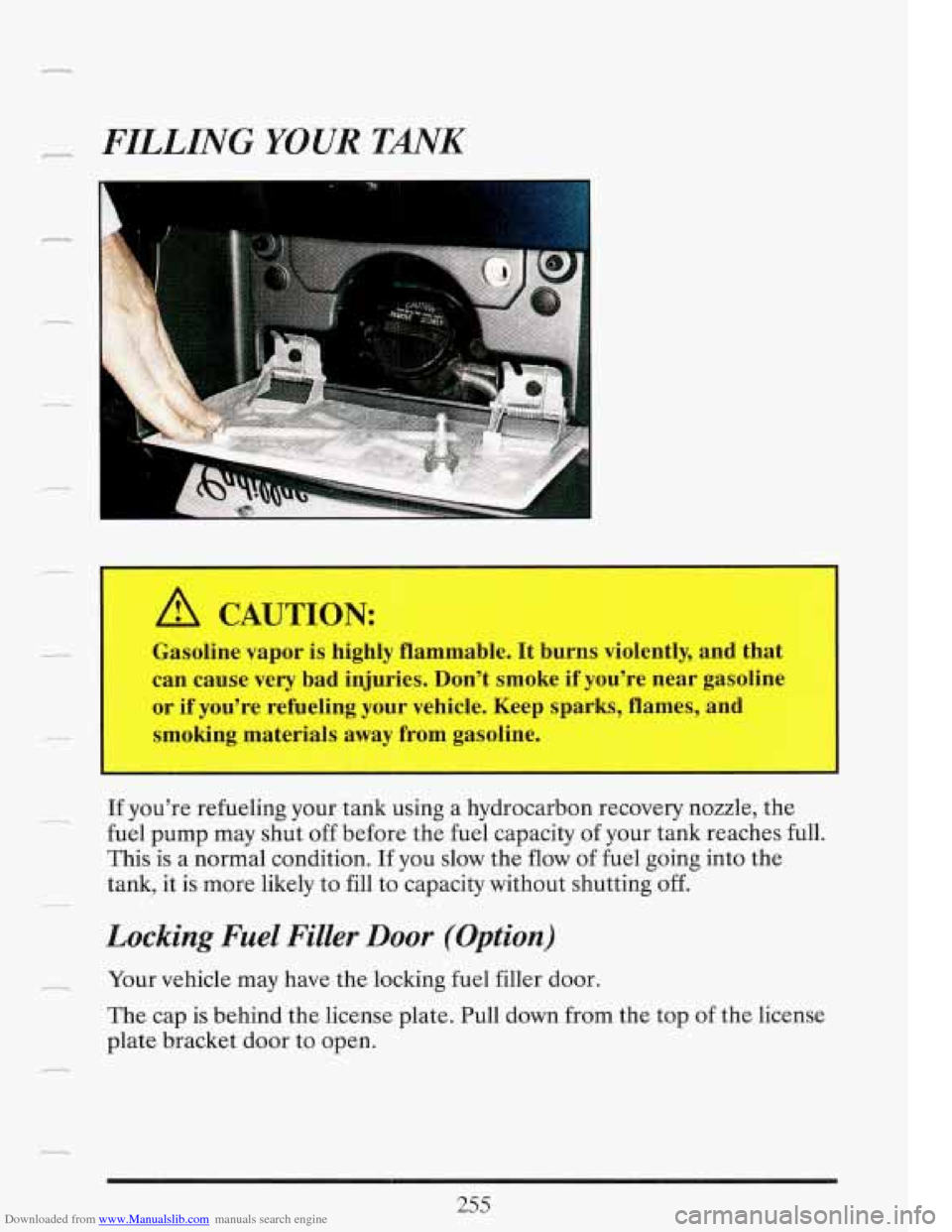
Downloaded from www.Manualslib.com manuals search engine ,s-- FILLING YOUR TANK
A CAUTION:
Gasoline vapor is highly flammable. It burns violently, and that
can cause very bad injuries. Don’t smoke if you’re near gasoline
or if you’re refueling your vehicle. Keep sparks, flames, and
I
smoking materials away from gasoline.
c_ If you’re refueling your tank using a hydrocarbon recovery nozzle, the
fuel pump may shut off before the fuel capacity of your tank reaches full.
This is a normal condition. If you slow the
flow of fuel going into the
tank, it is more likely to fill to capacity without shutting off.
__
Locking Fuel Filler Door (Option)
m Your vehicle may have the locking fuel filler door.
The cap is behind the license plate. Pull down from the top of the license
plate bracket door to open.
255
Page 270 of 386
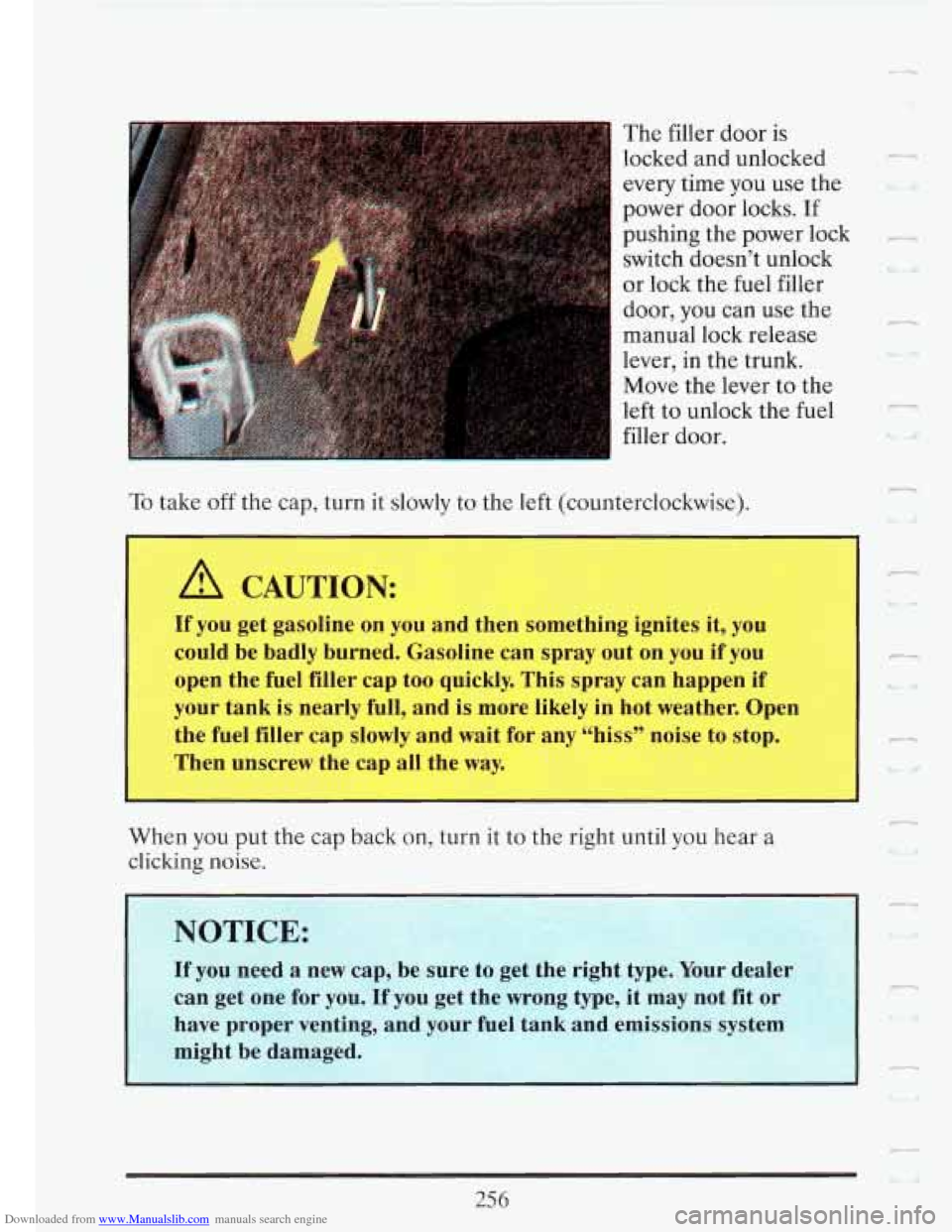
Downloaded from www.Manualslib.com manuals search engine The filler door is
locked and unlocked
every time you use the
I power door locks. If
pushing
the power lock _a
switch doesn’t unlock w
or lock the fuel filler
door, you can use the
manual lock release
lever,
in the trunk.
Move the lever to the
left to unlock the fuel
filler
door.
To take off the cap, turn it slowly to the left (counterclockwise).
I
A CAUTION:
If you get gasoline on you and then something ignites it, you
could be badly burned. Gasoline can spray out on you
if you
open the fuel filler cap too quickly. This spray can happen if
your tank is nearly
full, and is more likely in hot weather. Open
the fuel filler cap slowly and wait for any “hiss” noise to stop.
Then unscrew the cap all the
way.
When you put the cap back on, turn it to rhe rlgnt untu you near a
clicking noise
W
r
W
P
L- .&
U
7.
256